Are You One Of The 98%?
Hyundai knows that 98% of all people drive less than 100 miles daily. They also know, for the vast number of these people, owning a car that plugs into a socket would satisfy their driving pattern. So an opportunity exists…right? Well, it might be if Hyundai offered a family of cars with full or partial electric propulsion.
Welcome to the Ioniq line-up. Launched this year, the 2017 Ioniq comes as a hybrid, a pure-electric EV, and, at the end of 2017, a plug-in hybrid or PHEV. Clean Fleet Report will be posting our thoughts on the Ioniq Hybrid soon and the PHEV when it is released, but first off the Ioniq Electric gets our attention. One of my colleagues had a chance to drive the hybrid and electric versions back-to-back and this is what he thought.

The 88 kW electric motor puts out 118 hp and 215 lb-ft of torque. With the single-speed automatic transmission, there are no gear shifts to interrupt the power reaching the front wheels. The torque is available at any speed, any time, the acceleration is smooth, quiet and seamless. Typical freeway onramps and passing were done with ease.
I would not characterize the Ioniq Electric as fun to drive (that would be left to the Fiat 500e or Volkswagen e-Golf), but more stable and comfortable, both of which are fine attributes for any car. Handling came from the electric-powered steering and MacPherson strut suspension, making handling in-and-out of parking spaces, city driving and highway jaunts confident and sure. The 16-inch Michelin Energy Saver tires are made for low-resistance rolling, so no expectations on them to increase cornering ability. Remember, buy a car for what it is designed and made to do, not what you want it to do. So, in the case of the Ioniq Electric, Hyundai did not intend it to be a sports car, but a high-mileage, not-going-to-burn-any-fossil-fuels commuter and city car. It does the latter very well.
Charging and Stopping
The 2017 Hyundai Ioniq Electric has a lithium-ion battery (Li-Ion for short) that is charged through a plug-in port offering three charging speeds. Using the onboard 6.6kW charger, taking the batteries from full discharge to full charge will entail these time commitments:
- 120V (Level 1) 24 hours
- 240V (Level 2) 4 hours, 25 minutes
- 480V DC Fast Charging 80% in 30 minutes or less
The Ioniq Electric also uses a regenerative charging system, which converts kinetic energy into electronic energy and stores it in the battery when applying the brakes or coasting. A feature you will use frequently, and come to enjoy and rely on, are the brake control paddles that are located where paddle shifters would be on a car with a transmission. When applied, they act as the car’s brakes, allowing you to slow the car just a little or really chomp down where you feel the need for deceleration. More clicks applied to the left paddle delivers more energy to the battery. It is a very cool system that has a dash indicator showing what level of brake pressure is being applied. All EVs should have this feature and technology.

The all-wheel anti-lock brakes (ABS) have electronic brake-force distribution, brake assist, electronic stability and traction control, to give the Ioniq Electric solid, straight and true stops.
Not a Wedge
The Ioniq Electric has smooth body surfaces with few creases or sharp edges. It looks nothing like a wedge of cheese rolling down the road. It also is quickly differentiated
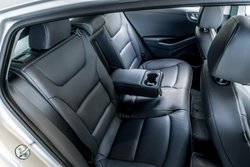
from its hybrid sibling: no front grille to let air into the radiator, as there’s no radiator cooling the engine since there is no engine. A flat nose replaces the grille, which adds to the low 0.24 coefficient of drag, the same as the Tesla Model S. Nice company to keep.
Front LED headlights are standard, but our test Ioniq Electric had the optional HID (High Intensity Discharge) headlights, with the very cool and helpful dynamic bending light function. Both types of headlights are stylish and functional, aiding in the aerodynamic design. Even the five-spoke, 16-inch alloy wheels were built to cut through the wind. The hatch, with a built-in combination deck lid/spoiler that divides the glass, is bordered on each side by LED tail lamps. It took some getting used to—looking in the rearview mirror and seeing the horizontal deck lid/spoiler in the rear window—but after some mental and visualization adjustments, it became normal and natural and was not an issue.
Interior Built for Comfort
Clean Fleet Report’s Ioniq Electric Limited’s interior was very well-equipped and appointed. The black, with matching black topstitching, dash and doors were outfitted with soft and hard plastic surfaces, accented by a very tasteful use of brushed aluminum trim pieces. The gauges and controls were conveniently located, with a digital dash having several settings to read a wide assortment of data. The center console dividing the heated, leather seats (power adjustable for the driver and manual for the passenger) has a unique shift-by-wire push button drive system. It was easy to become acclimated once you remembered not to be looking for a shift lever.

As with the front seating area, the rear seats are black leather, but with white topstitching, and are made for grown humans. Divided into two comfortable seats by the fold down armrest, our Limited edition rear compartment had ample leg, shoulder and head room. For storage, the rear seat folds 60/40. The LED illumination throughout the cabin is a step-up touch.
The infotainment (information and entertainment) system was centered around the optional eight-speaker Infinity Premium Audio with an eight-inch color touchscreen and navigation. The system includes HD FM/AM, SiriusXM (90-day subscription included), CD player, iPod, Apple CarPlay and Android Auto, all of which can be managed by the leather-wrapped steering wheel-mounted controls. Other features of the system include USB, AUX and audio input jacks and Bluetooth for voice controls and hands-free telephone calling.
Standard and optional convenience features include wireless phone charging, power tilt-and-slide sunroof, power windows with one-touch down, power door locks, power and heated foldaway exterior mirrors with puddle lamps. Also on board are automatic climate control, electronic parking brake, floor mats, push button start, proximity keyless entry, 12V and USB power outlets, multiple cup holders, auto-dimming rear view mirror with Homelink, security alarm, tire pressure monitoring system and a tire service kit in lieu of a spare tire.
Safety Features
Standard and optional safety features include seven airbags, blind spot detection with cross traffic alert and lane change assist, lane departure warning, rear view camera, automatic emergency braking, smart cruise control with stop/start and hill start assist.
The 2017 Hyundai Ioniq Electric has not been rated by National Highway Traffic Safety Administration or the Insurance Institute for Highway Safety.
Pricing and Warranties
The base MSRP for the two 2017 Hyundai Electric models.
- Ioniq Electric $29,500
- Ioniq Limited $32,500
Clean Fleet Report’s Ioniq Electric Limited came with the optional Ultimate Package that added $3,500, for a total of $36,000. All prices do not include the $885 freight
charge or any federal or state tax credits.
The Ioniq Electric comes with these warranties.
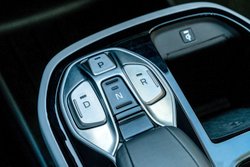
Electric Battery Lifetime/Unlimited Miles
New Vehicle Five Years/60,000 miles
Powertrain Ten Years/100,000 miles
Anti-Perforation Seven Years/Unlimited Miles
Roadside Assistance Five Years/Unlimited Miles
Observations: 2017 Hyundai Ioniq Electric
1%. No, not the one-percent that has been a political hot topic button.
This is the market share of plug-in electric vehicle sales in the United States, with the majority of those being in California (where the share is higher). So when Hyundai decided to introduce its all-new 2017 Ioniq Electric sedan, it did so first in California. Being a bit late to the EV market, Hyundai needed to raise awareness of its compact quickly, so they offered a solidly built car with the highest MPGe, the best warranty, a class-leading low price and a program to reimburse lease owners for their electricity bill.

We are entering a new phase for EVs. The Chevrolet Bolt was the first of the lower priced/longer-range cars. The Bolt, with an Environmental Protection Agency estimate driving distance of 238 miles, far outpaces the Ioniq Electric that is rated at 124 miles. The Tesla Model 3 is rated at between 210 and 315 miles, based on which model you buy. So it would seem an easy decision to buy the Bolt or Model 3. But, hold on a minute!
Also to be considered is MPGe. Standing for Miles Per Gallon Equivalent, MPGe is how far an all-electric car can travel on the equivalent to one gallon of gasoline. Coming out on top is the Ioniq Electric at 136 MPGe, with the Bolt at 119 MPGe and the Model 3 rated at 101 MPGe. So go with the Ioniq, right? Hang on.
While MPGe and driving distance are important, don’t forget the purchase cost. The Bolt base price is $37,500, the Model 3 base price is $35,000 and the Ioniq Electric is the lowest at $29,500. All prices are before any options, delivery fees or federal or state tax rebates.
With the Hyundai Ioniq getting a 2 out of 3 score on MPGe and price (at the top end of the chart), the decision should be easy. But again, hold on a minute. You must think about where and how you drive. By choosing the Ioniq Electric, this means the vast majority of your driving will only be a bit over 100 miles one-way (with a charge before the return on longer distances). Is that enough distance? If you want to go from Santa Monica to San Luis Obispo in California, or maybe New York City to Boston, or Miami to Orlando, the EPA says you won’t make it in the Ioniq on a single charge, but will in the Bolt or the Tesla Model 3. However, since the Ioniq is equipped for 480V fast charging, you could extend your drives. Dizzy? Sit down before you fall down.
To simplify this, we will go on the premise that a driving distance under 124 miles suits you just fine, as it would for about 99-percent of all EV owners. Therefore, considering all the above, the Ioniq Electric just may suit your driving lifestyle and be the easiest on your budget.
When visiting your Hyundai dealer, make sure to either make an appointment with, or speak with, a factory-trained electric vehicle specialist. Then treat yourself to a lengthy test drive and you just may drive home in something you never thought would be in your garage–a car that never, ever needs to stop at a gas station.
Whatever you end up buying, enjoy your new car and as always, Happy Driving!
Related Stories You Might Enjoy:
Comparison Test: 2017 Hyundai Ioniq Hybrid & Electric
Personal: Six Months with the Chevrolet Bolt
News: Tesla Model 3 First Deliveries
Road Test: 2017 Fiat 500e
First Drive: 2017 Volkswagen e-Golf
Disclosure:
Clean Fleet Report is loaned free test vehicles from automakers to evaluate, typically for a week at a time. Our road tests are based on this one-week drive of a new vehicle. Because of this we don’t address issues such as long-term reliability or total cost of ownership. In addition we are often invited to manufacturer events highlighting new vehicles or technology. As part of these events we may be offered free transportation, lodging or meals. We do our best to present our unvarnished evaluations of vehicles and news irrespective of these inducements.
Our focus is on vehicles that offer the best fuel economy in their class, which leads us to emphasize electric cars, plug-in hybrids, hybrids and diesels. We also feature those efficient gas-powered vehicles that are among the top mpg vehicles in their class. In addition, we aim to offer reviews and news on advanced technology and the alternative fuel vehicle market. We welcome any feedback from vehicle owners and are dedicated to providing a forum for alternative viewpoints. Please let us know your views at publisher@cleanfleetreport.com.

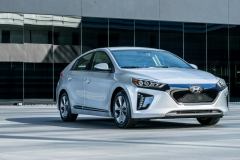
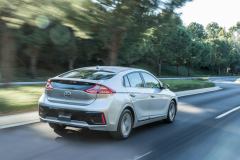

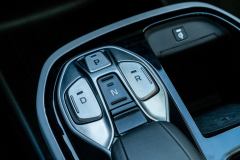
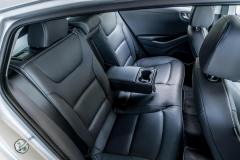
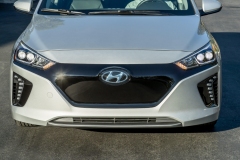
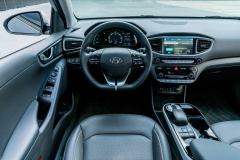
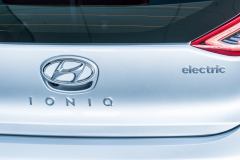
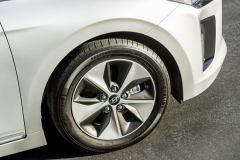
12 thoughts on “Road Test: 2017 Hyundai Ioniq Electric”